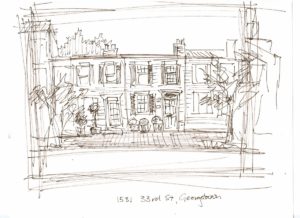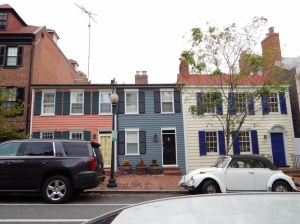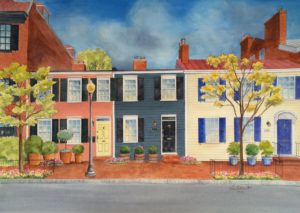The story of the Commissioned Architectural Painting
A young couple in Georgetown DC decided that wanted me to create a large and vibrant painting of their house and street to hang on a brick feature wall in their home. The first step was the planning stage to work out the best angle and composition.

Here is the main photo that was used, minus the cars of course! Love the colors of these homes. Georgetown, besides being one of the most historic neighborhoods in DC, it is also extremely popular as a tourist site and hang-out for just about anyone. It’s hard to believe that after WWI Georgetown became one of the worst slums in the Washington district!

The final pen and watercolor painting.

And here it is with the proud owners!

Here’s a little history regarding Georgetown.
It was formally established in 1751 when the Maryland Assembly authorized a town on the Potomac River on 60 acres of land belonging to George Beall and George Gordon. George Town was named in honor of King George II and soon flourished as a shipping center. Tobacco was the lifeblood of the community, and Georgetown soon prospered as a shipping center with a profitable European and West Indian trade. Commerce and industry developed along the waterfront, where wharves and flourmills were constructed. During the Revolution, Georgetown served as a great depot for the collection and shipment of military supplies. When the town was finally incorporated in 1789, a textile mill, paper factory and more flourmills were established. Georgetown’s character was profoundly affected by the establishment of the nation’s capital to the east in 1791. Although it was included in the new Federal District, it retained its own character.
Georgetown rapidly gained a reputation as the fashionable quarter of the capital and drew eminent visitors from this country and others. Congress incorporated Georgetown as part of Washington City in 1871. After the Civil War, large numbers of freed slaves migrated to Georgetown. The African American community flourished, becoming increasingly self-reliant. In the 1880s the waterfront prospered. But in the 1890s the water canal was severely damaged by a Potomac River flood, and the Canal Company was bankrupted. The area went into an economic decline and in the period after World War I, Georgetown gained a reputation as one of Washington’s worst slums; its homes were neglected and the area deteriorated badly. This trend began to reverse itself in the 1930s with the New Deal and reached a high point when Senator John F. Kennedy resided in the neighborhood in the 1950s.
So there you go!
Leisa


